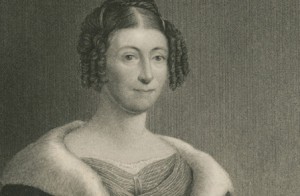[Posted by Erika Jenns, Indiana University ’13, who is performing an internship in the Watkinson by contributing to this blog about our collection of Sigourney items.]
 Nestled between Harriet Beecher Stowe and Henry Miller on compact shelves at the Watkinson, I found Lydia H. Sigourney’s impressive array of published works awaiting me, in modest, patient rows.
Nestled between Harriet Beecher Stowe and Henry Miller on compact shelves at the Watkinson, I found Lydia H. Sigourney’s impressive array of published works awaiting me, in modest, patient rows.
 The gilt bindings in various colors require the space of five shelves, and this is only half the collection. As I labored over 135 “Sigourney” entries in the Watkinson catalogue, pulling each item from the shelves, I began to ponder the life of a book living down beneath the Watkinson reading room, pressed so close to fellows or strangers. I’m not sure which would be more agreeable, to be sandwiched between sister and brother editions, next to a distant cousin with a different name, or cozied up with an individual created by another pen entirely.
The gilt bindings in various colors require the space of five shelves, and this is only half the collection. As I labored over 135 “Sigourney” entries in the Watkinson catalogue, pulling each item from the shelves, I began to ponder the life of a book living down beneath the Watkinson reading room, pressed so close to fellows or strangers. I’m not sure which would be more agreeable, to be sandwiched between sister and brother editions, next to a distant cousin with a different name, or cozied up with an individual created by another pen entirely.
 The majority of Sigourney’s books have been assigned spaces next to family members. Her first book, Moral Pieces, was published in 1815, and the three editions, all in a row, show the signs of aging. Two reside in boxes to prevent the loss of their covers or delicate pieces of their spines, and while the hinges of the third remain intact, the beautiful gilded roses on the spine have begun to disappear. Other titles boast their youthfulness with their well-intact, heavily gold-stamped spines shining out from between some of their less fortunate family members. I have yet to uncover the details of their lives.
The majority of Sigourney’s books have been assigned spaces next to family members. Her first book, Moral Pieces, was published in 1815, and the three editions, all in a row, show the signs of aging. Two reside in boxes to prevent the loss of their covers or delicate pieces of their spines, and while the hinges of the third remain intact, the beautiful gilded roses on the spine have begun to disappear. Other titles boast their youthfulness with their well-intact, heavily gold-stamped spines shining out from between some of their less fortunate family members. I have yet to uncover the details of their lives.
 The mother of these creations, Lydia Howard Huntley Sigourney, was born in Norwich, Connecticut on September 1, 1791. In 1811 she and her friend, Nancy Maria Hyde, opened a school for girls, but it closed soon after when Hyde became ill. In 1814, Sigourney moved to Hartford and established another school for girls in the home of Daniel Wadsworth. Wadsworth later arranged for the publication of Moral Pieces. Four years later, she married Charles Sigourney. He did not support her ambitions as a writer, so she began to publish her works anonymously. She often donated the profits from her publications to various organizations, such as, “the temperance movement, peace societies, and missionary groups,” but as her husband’s financial situation deteriorated, Sigourney began publishing under her own name again. Her profits became the source of the family income.
The mother of these creations, Lydia Howard Huntley Sigourney, was born in Norwich, Connecticut on September 1, 1791. In 1811 she and her friend, Nancy Maria Hyde, opened a school for girls, but it closed soon after when Hyde became ill. In 1814, Sigourney moved to Hartford and established another school for girls in the home of Daniel Wadsworth. Wadsworth later arranged for the publication of Moral Pieces. Four years later, she married Charles Sigourney. He did not support her ambitions as a writer, so she began to publish her works anonymously. She often donated the profits from her publications to various organizations, such as, “the temperance movement, peace societies, and missionary groups,” but as her husband’s financial situation deteriorated, Sigourney began publishing under her own name again. Her profits became the source of the family income.
Sigourney was “one of the first women in the United States to establish a successful and remunerative career as a writer.” She published 67 books in her lifetime, edited The Religious Souvenir from 1839 to 1840, and “from 1839 to 1842, she was listed as an editor of Godey’s Lady’s Book, primarily for the prestige her name conferred on the journal.” Sigourney died in her Hartford home in 1865, and her autobiography, Letters of Life, was published a year later.